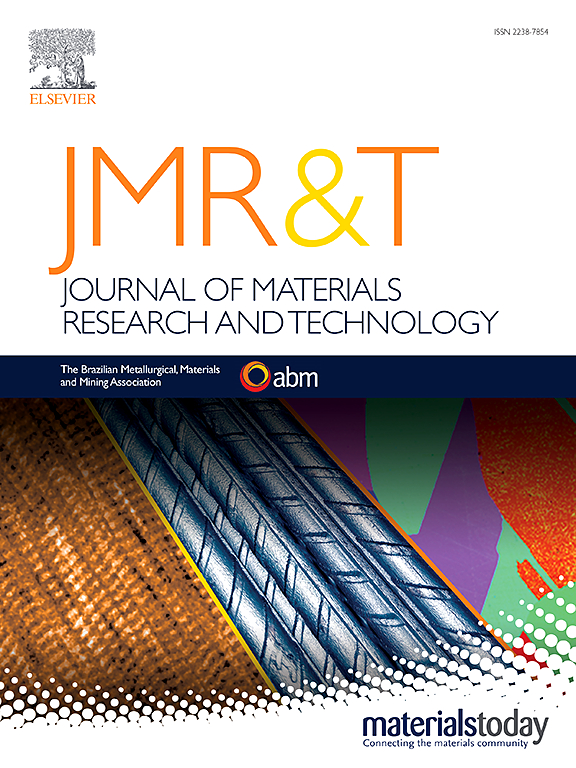用田口法优化7075铝合金等离子体电解氧化工艺参数
IF 6.6
2区 材料科学
Q1 MATERIALS SCIENCE, MULTIDISCIPLINARY
Journal of Materials Research and Technology-Jmr&t
Pub Date : 2025-06-05
DOI:10.1016/j.jmrt.2025.06.033
引用次数: 0
摘要
本研究采用田口设计的实验方法,通过优化等离子体电解氧化(PEO)涂层的电流密度、时间、频率和占空比等工艺参数,提高AA7075合金等离子体电解氧化(PEO)涂层的耐蚀性。这些参数的最佳值分别确定为40 A/dm2, 15 min, 1500 Hz和30%。讨论了各参数对PEO涂层耐蚀性能的影响,发现占空比是影响PEO涂层耐蚀性能最显著的参数。优化后涂层的极化电阻达到105.206 MΩ cm2,是基材的49倍。这一改进表明,PEO涂层对腐蚀剂的阻隔效果增强,这表明优化后的PEO涂层在航空航天和海洋等苛刻的工业环境中具有很大的应用潜力。电化学阻抗谱(EIS)的结果也表明耐蚀性能有所提高。利用扫描电子显微镜(SEM)和能谱仪(EDS)对优化后涂层的微观结构和表面形貌进行了分析,发现其具有典型的PEO涂层结构。涂层的孔隙率为3.95%,微孔平均直径为1.57 μm。涂层的组成元素是铝、氧、硅、镁和锌。涂层与基体的附着力较好,涂层厚度为9.4 μm。x射线衍射(XRD)分析表明,涂层的主要相为γ -氧化铝和氧化镁。本文章由计算机程序翻译,如有差异,请以英文原文为准。
Optimization of the plasma electrolytic oxidation process parameters on 7075 aluminum alloy using Taguchi method
In this study, the objective was to enhance the corrosion resistance of plasma electrolytic oxidation (PEO) coatings on AA7075 alloy by optimizing the PEO process parameters including current density, time, frequency, and duty cycle, using the Taguchi design of experiments method. The optimal values for these parameters were determined to be 40 A/dm2, 15 min, 1500 Hz, and 30 %, respectively. The influence of each parameter was also discussed, and it was found that the duty cycle was the most significant parameter influencing the corrosion resistance of the PEO coatings. The polarization resistance of the optimized coating reached 105.206 MΩ cm2, which was 49 times higher than the substrate. This improvement indicates an enhanced barrier effect against corrosive agents, suggesting the potential of the optimized PEO coating for use in demanding industrial environments such as aerospace and marine applications. The results of electrochemical impedance spectroscopy (EIS) also indicated an improvement in corrosion resistance. The microstructure and surface morphology of the optimized coating were examined using scanning electron microscopy (SEM) equipped with energy-dispersive X-ray spectroscopy (EDS), which revealed a typical structure of PEO coatings. The porosity of the coating was 3.95 % and the average diameter of micropores was 1.57 μm. The constituent elements of the coating were aluminum, oxygen, silicon, magnesium, and zinc. Additionally, the coating exhibited good adhesion to the substrate, and the thickness of the optimized coating was 9.4 μm. X-ray diffraction (XRD) analysis revealed that the main phases of the coating were gamma-alumina and magnesium oxide.
求助全文
通过发布文献求助,成功后即可免费获取论文全文。
去求助
来源期刊

Journal of Materials Research and Technology-Jmr&t
Materials Science-Metals and Alloys
CiteScore
8.80
自引率
9.40%
发文量
1877
审稿时长
35 days
期刊介绍:
The Journal of Materials Research and Technology is a publication of ABM - Brazilian Metallurgical, Materials and Mining Association - and publishes four issues per year also with a free version online (www.jmrt.com.br). The journal provides an international medium for the publication of theoretical and experimental studies related to Metallurgy, Materials and Minerals research and technology. Appropriate submissions to the Journal of Materials Research and Technology should include scientific and/or engineering factors which affect processes and products in the Metallurgy, Materials and Mining areas.
 求助内容:
求助内容: 应助结果提醒方式:
应助结果提醒方式:


